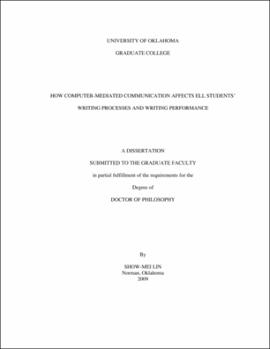| dc.description.abstract | The overarching purpose of this study was to examine the impact of CMC technology on ELL students' writing processes and writing performance through interacting, communicating, constructing knowledge, and collaborating with peers from different cultural and linguistic backgrounds. This study intended to reform teaching methods for ELL writing from a teacher-centered approach to a student-centered approach. In addition to the discussion forum (NICENET), used to address students' individual learning needs, this study incorporated CMC technology tools that supported tutorial writing lessons (Essay Punch, Paragraph punch), interactive multimedia grammar practices (Grammar Fitness), online bilingual dictionaries, and other online writing links (websites/labs) to improve students' writing skills. Offering unlimited time (class time) and place (classroom), CMC technology incorporated both individualized learning processes and social interaction learning to facilitate ELL writing processes and writing outcomes. | |
| dc.description.abstract | Mixed methods were utilized in this study: quantitative methods, including writing difficulties/needs questionnaires, quantity of participation, pre-test quality (score) of writing samples, post-test quality (score) of writing samples, and qualitative research methods, including reflection journals and interviews. | |
| dc.description.abstract | The results of the questionnaire data showed that most ELLs perceived their highest writing difficulties (needs) in linguistic/cognitive deficiencies (M=3.91; SD=.53), next highest in psychological/emotional deficiency (M=2.78; SD=1.20) and the third in sociocultural aspects of writing difficulties(M=2.50;SD=1.00 ). After CMC technology intervention designed to address students' self-perception of writing difficulties (needs), sociocultural (percentage gains= -21%) aspects of writing difficulties were reduced the most, cognitive/linguistic (percentage gains= -18%) aspects of writing difficulties were reduced the second, and psychological/emotional (percentage gains=-17%) aspects of writing were reduced the least. In terms of students' writing performance, there was a trend towards an improved level of performance. Students showed improvement in their quantity of writing, organization, thesis statements, ideas, and use of multiple perspectives. However, a majority of students did not show much improvement in grammar usage (run-on sentences and articles) and word choice. Comparing two groups, the CMC technology group outperformed the control group on self-perceptions of sociocutlrual and, psychological/emotional aspects of writing, and in percent gains between pretest and posttest of writing performance. During the writing processes, there were advantages and disadvantages about using CMC technology for ELL writing instruction. A majority of students had a high level of positive perceptions of CMC technology and participation, had a high level of discussion, reduced their writing anxiety, became more confident, and felt that they made progress in multiple perspectives, critical thinking, identifying writing errors, spelling, grammar, implementing writing processes, and adapting to American writing conventions. Participants described advantages most on cognitive/linguistic aspects of writing. On the other hand, the cognitive/linguistic disadvantages included conflicting feedback, longer time for revising, and harder revision. The technological difficulties included lack of creativity and flexibility in the writing software. The sociocultural difficulties were spending much more time on building an online learning community for emotional support and knowledge sharing/building. In the beginning of the study, students were reluctant to share with their ELL peers about their English writing because they were afraid that their peers might look down upon their writing abilities or they did not have confidence in their ELL peers' writing ability to be able to offer constructive or meaningful feedback and suggestions. However, gradually students began to establish a learning community where they not only helped each other to write but also offered emotional support to their peers by showing empathy and suggesting problem-solving strategies in their writing. Students became actively in using writing to express ideas, negotiate differences, support other people's emotional needs, and solve problems. Metacognitive strategies and higher-order cognitive strategies were facilitated through online discussion and interaction. | |
